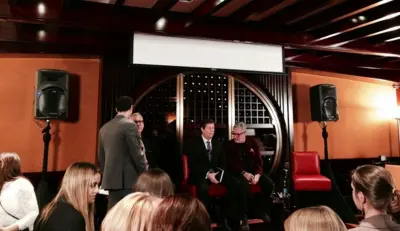Last week we had the pleasure of attending an Afar Conversations event on The Evolution of the Luxury Consumer at The Chatwal here in NYC. AFAR Media brought together leaders in experiential travel to host a lively (and at times, hilarious) discussion on today and tomorrow’s luxury consumer.
With perspective from Hilton’s Global Head of Luxury Brands, John T.A. Vanderslice, preeminent hospitality designer, Adam Tihany and Walter Coyle, President of Pedone Media, there was ample opportunity for both consensus and divergent opinions. Below, the top three trends in experiential luxury from the conversation.

MILLENNIALS ARE THE MOST DEMANDING LUXURY CONSUMER YET
In a surprise to no one, Millennials may be the most demanding luxury consumer, but it’s probably not in the way you think. While the older consumer of a luxury travel experience appreciates and expects to be waited on by a personal concierge, always present and available, Millennials prefer their wants to be tended to seamlessly—ideally remotely and before the need even arises.
Hilton conducted some interesting testing on the success of a personal concierge app, and the response from Millennials was overwhelming. The ability to ask for your bags to be unpacked in a certain way, to have specific groceries waiting, schedule events and wake up calls, pre-order room service (the possibilities are extensive) resonated with the consumer who’s first thought it to order an Uber, schedule Glamsquad and open Flavour for curated local restaurant recommendations. The millennial consumer’s OS is fundamentally different than the baby boomer, for example. It’s critical that luxury brands build their service programs to meet the consumer at the right time and place, answering their need-state with relevant offerings. In support of that thought, Walter Coyle of Pedone Media commented, “As the world had become more global people want more to embrace those unique luxury experiences.” It’s the way a brand delivers those experiences that has to be reconsidered.
THE LUXURY CONSUMER WILL ALWAYS PAY FOR AN EXPERIENCE
There was an overwhelming consensus on the matter of true luxury resting on what John Vanderslice referred to as “software, not hardware,” as in the human experience provided (service) and received, not hard goods. Adam Tihany echoed that sentiment, “The most important ingredient in luxury is the human touch. Without that, you just have amenities,” adding, “Luxury is the minute details that add up to someone having designed something to your human scale.”
It’s no surprise that Laura Davidson, founder of LDPR, expressed the same idea in reference to LDPR client Abercrombie & Kent in a recent Q&O interview with The O Group.
FOR THE LUXURY CONSUMER TIME IS THE MOST VALUABLE RESOURCE
When you place time at a premium, a seamless, unforgettable experience that surprises and delights – whether you’re purchasing a handbag or traveling the Serengeti – is beyond a price tag. The mark of that experience? If at the end of the day you hand over your card and think to yourself, “You couldn’t charge me enough for this,” (as Adam Tihany did of a hotel experience in Mexico).
FEMALE-FRIENDLY LIFESTYLE BRANDS COULD FILL A WHITE SPACE ACROSS LUXURY
We’ve all heard the logic: women will purchase a masculine branded product, but men are much less likely to do so. It makes sense, right? Women purchase Bailey’s, but they’re just as likely recently to purchase a small-batch whiskey that looks like it was hand labeled in a 19th century apothecary. “Mens-wear” is consistently popular women’s fashion, but “womens-wear” for men? Far less mainstream. With all that in mind, our speakers turned to the idea of a luxury lifestyle brand that caters more to women than men. In all fairness, Vanderslice of Hilton referenced qualities such as “light, bright and airy” and “celebrating the neighborhood” in describing a Hilton brand in development—hardly attributes likely to alienate a man.
That said, the idea still stands: with women more likely to purchase luxury products as a means of “self-reward and pampering” (Source: KMPG) and “Senior women age 50 and older [controlling a] net worth of $19 trillion and own more than three-fourths of the nation’s financial wealth” (Source: Mass Mutual Financial Group) – why not skew more female in branding? How much market share are brands who continue to ignore the possibilities of a more “female-friendly” offering losing? It’s an interesting perspective to consider, and one we’re excited to think about across categories.